Triton,
Pluto-Charon, Kuiper Belt and the Oort Cloud
Itís probable that in the primordial times of the solar system a vast
population of icy bodies inhabited in the region where Uranus and Neptune orbit
today:
- On one hand, it is thought that a big
quantity of mass (100 terrestrial masses) populated this region
immediately after the solar system genesis, contrarily to the relatively
low quantity of mass that ended up being incorporated in Uranus and Neptune (30 terrestrial masses).
Therefore, thereís a good indication that the majority of the
planetesimals that were accumulated there have been, in a subsequent
period, gravitationally ejected by these two planets into the
interstellar space, outside the solar system, or into the so-called Oort
Cloud;
- Another factor suggesting the existence
of this primitive population of planetesimals are 4 coincidences whose
joint occurrence would be highly improbable in the case that this
population had never existed. First, the inclinations of the rotation
axis of Neptune (30ļ to the solar systemís
plane, or ecliptic) and Uranus (98ļ) are only explainable in
the case these planets have been, some time in the solar systemís
history, targeted by objects of considerable dimension, during their
formation processes. Second, there is the case of Triton, with a surface
geologically altered and orbiting in a backward direction relatively to
the rotation of the mother-plane (it is the only large satellite, in the
whole solar system, that displays this characteristic). Triton appears to
have been captured by Neptune in a remote time, which would be also a
highly improbable event if, when it occurred, few bodies of comparable
dimensions had orbits close to the one of this giant planet. At last,
itís remarkable the existence of a double planet Pluto-Charon. A capture
of Charon by Pluto would have also been highly improbable if this region
wasnít, during that period, densely crowded with bodies of dimensions
comparable to those of these 2 objects;
- Finally, the discovery of large objects
like the recently detected asteroid Quaoar (with a diameter between 1200 and
1400 km and presently orbiting the Sun at a distance of 6500 million km),
boost the idea that more objects with similar sizes may inhabit a region
that extends fairly beyond Neptuneís orbit, favouring the thought that
such kind of objects could also be common between the orbits of Uranus
and Neptune.
Therefore, itís probable that Pluto, Charon, Triton and Quaoar, as well
as the smaller Chiron (a body that orbits between Saturn and Uranus but that,
very likely, proceeds from a region farther away from the Sun) and Phoebe (a satellite captured by
Saturn) may be remnants of a vast population of icy objects that occupied the
outer solar system, at the time of its formation. Those that didnít escape the
gravitational disturbances caused by Uranus and Neptune (there could be
thousands of them with sizes comparable to the objects that are mentioned
here), probably survive today in the Oort Cloud (1/3) or else, they were
definitely expelled from the neighbourhood of our planetary system (2/3).
Triton
Triton is the largest satellite of Neptune and it is, as it was
said, the only big satellite of the solar system that orbits around the planet
in a backwards (clockwise) direction.
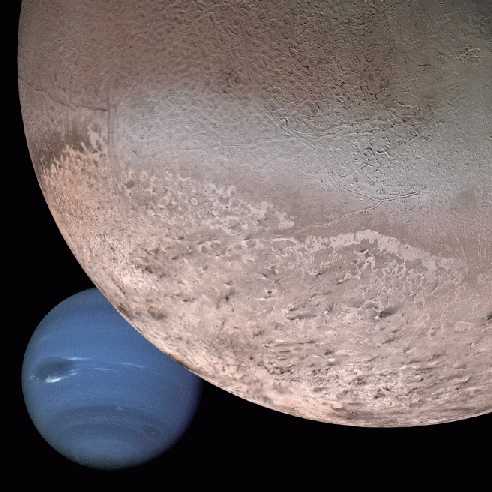
Triton, with Neptune in
the background (NASA - JPL)
The Capture
Given the peculiar characteristics of its orbit, itís thought that
Triton is a satellite formed far away from Neptune that was later captured by it. This event could have
supplied to Triton all the necessary energy that could melt and differentiate
its interior.
A Not Very Smiling Future
The backwards orbit of Triton makes us also believe that in a remote
future the satellite approaches Neptune so much
that it will fall inside the Roche limit and
destroyed, being transformed in a ring.
Interior
Given its density, itís thought that Triton is composed by 25% of water
ice and 75% of rocky material, more than anyone else among the other icy
satellites of Saturn and Uranus.
Surface
The surface is relatively young, which is demonstrated by the small
amount of craters.
The southern hemisphere is covered by a big polar cap of frozen nitrogen
and methane, with a slightly pinky colour and variable dimensions according to
seasonal factors.
Numerous and long grooves are pictured at the surface of this satellite,
being probably the result of freezing and defreezing cycles. In the equatorial
zones, itís particularly remarkable the existence of a continuous sequence of
nearly circular cliffs, close to the barriers of linear elevations and valleys.
There are also, in this region, zones that are rich in volcanic craters
of modest relief. They may have been the result of emissions of fluid material
like methane, ammonia and water. These structures may represent the remnants of
a set of ancient fractures and convection cavities. They are possibly related
with a period of heating provoked by the capture of Triton by Neptune.
The ice volcanos (geysers) are some of the most interesting features of
Triton and are the result of eruptions of liquid nitrogen, dust and methane
composites proceeding from the interior. Itís thought that the seasonal heating
in Triton may determine the appearance of this kind of volcanic phenomena.
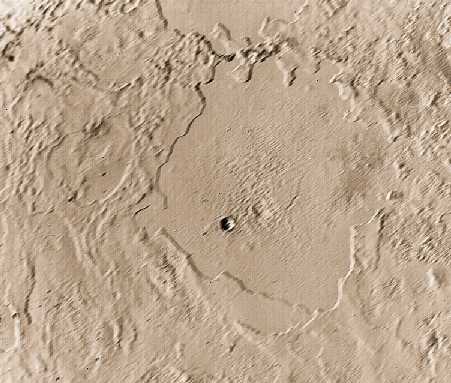
Detail of the surface of
Triton (Calvin J. Hamilton)
Atmosphere
Triton possesses a very rarefied atmosphere (pressure of 0,01 millibar,
the same as 1 / 100 000 of the Earthís) composed almost entirely by nitrogen
and some methane. A thin haze extends up to an altitude of 5 to 10 km. The
temperature in Triton is only 34,5 ļK, as low as in Pluto. At this temperature,
the nitrogen as the methane or the carbon dioxide solidify.
Pluto-Charon
As it was told, Pluto (with a diameter of 2300 km) and Charon (1190 km)
are the components of a double planet, given the comparability between the
masses and dimensions of both objects.
Density
The mean density of these bodies reveals a rockier and less icy
composition than that in the satellites of Uranus
and, over all, the satellites of Saturn. Quite probably, that is due to the fact that the trend for
the increase of the water availability in the solar system as we get away from
the Sun (given the volatility of this molecule) is reverted at the region of Saturn, given the increasing
proportion of solid forms of carbon.
Pluto vs. Charon
The surface of Charon, as well as the Plutoís, contains appreciable
amounts of water but the methane, present at the surface of Pluto, seems to be
almost absent from the surface of its satellite. Probably, the volatility of
this molecule provoked its gradual escape from the surface of Charon, but a
considerable proportion of it was then captured by the gravity of Pluto.
Surface and Atmosphere of Pluto
In Pluto, a large proportion of the surface seems to be covered by
nitrogen, and there are also small pockets that are rich in carbon monoxide.
Given the high eccentricity of the Plutoís orbit around the Sun (the highest
among the planets in the solar system), this planet heats when it approaches
the perihelion (the point where it is closer to the Sun), and then the surface
methane will evaporate in order to form a tenuous atmosphere. When Pluto is
again on the way back, getting farther away from the Sun, the methane cover is
deposited again over the surface. The nitrogen is, nevertheless, the main
component of the Plutoís atmosphere.
The
Kuiper Belt and the Oort Cloud
Beyond Pluto there are 2 comet reservoirs with different evolutions and
characteristics: the Kuiper belt (the source of the short period comets) and
the Oort cloud (the source of the long period comets).
The Kuiper Belt
The Kuiper belt is composed by a vast quantity of icy objects that never
came to gather in order to form large planets. These bodies were kept in their
primordial orbits, because the distance at which they were from the Sun allowed
them to escape the gravitational disturbances caused by Neptune. The Kuiper belt is the source of the short period comets,
as the comet Halley. More than 400 Kuiper belt objects are currently know to
exist. This belt extends to a distance of about 7500 million km from the Sun.
The Oort Cloud
Beyond the Kuiper belt we find the Oort cloud (extending between a
distance of 0,15 and 1,5 light-years from the Sun), presumably the source of
the long period comets, which is thought to be composed by trillions of frozen
objects, totalizing a mass that is about 25 times the Earthís mass.
Itís thought that the large majority was originated in the solar system,
close to the giant planets (namely Neptune and
Uranus), having been further expelled into this region. Other planetesimals,
affected by the gravity of the giant planets, would have
collided with them or been thrown into the inter-stellar space, when the
disturbance was strong enough for that.
Disturbances provoked by the close encounters with stars may be the
cause for the throwing of the comets inhabiting the Oort cloud into the
inter-stellar space or else, for a trajectory change that throws them into the
internal solar system.
The cyclical crossing of the Sun through the galactic
plane may be the responsible factor for periodical comet showers that may
have devastating consequences for life on Earth, as when a catastrophic impact
caused the extinction of the dinosaurs.
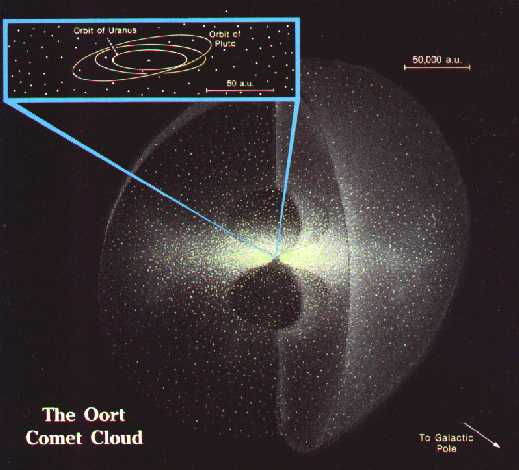
The Oort cloud (The New
Solar System - 3rd edition)

Sedna (at the end of the
green arrow), with a diameter between 1250 and 1800 km, is probably the most distant
object ever discovered in the Solar System. Its orbit extends between 11.400
million km from the Sun and almost 130.000 million km (nearly 0,013
light-years) from it. Itís thought that it has been affected by some kind of gravitational
perturbation, because itís placed in an empty region between the Kuiper Belt
and the Oort Cloud.
Comets
The comets are objects that preserve most of the primordial
characteristics of the bodies that gave birth to the solar system, although
they have been altered by occasional collisions with other members of the Oort
cloud, by the cosmic rays radiation (proceeding from the Big
Bang) and by the heat caused by the encounters with close stars.
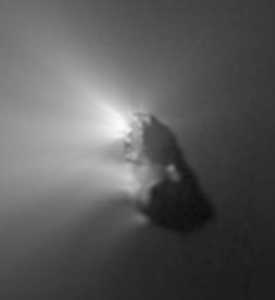
The nucleus of the comet
Halley, releasing material (MPAE)
First Passages
They are mainly formed by frozen composites of hydrogen, carbon, oxygen
and nitrogen. When a comet approaches the Sun for the first time, their most
volatile elements begin to sublimate when it still stands beyond the orbit of Jupiter.
Subsequent Passages
In further passages, after the total sublimation of these elements, the
evolving cloud (coma) forms only when it reaches a distance of 450 million km from
the Sol (against the more than 700 million km where Jupiter is placed).
Coma and Hydrogen Cloud
The coma starts then to be composed essentially by water ice and dust. A
hydrogen cloud with much higher dimensions surrounds the coma. This is not
originated in the cometary nucleus (the sublimation doesnít explain the high
velocity of the gas inside the hydrogen cloud), but is rather the result of the
dissociation of the hidroxyl (OH) by the solar light.
Tails
At a distance slightly higher than 200 million km from the Sun, occurs
the formation of clouds that may reach tens of millions of kilometres long.
The dust expelled from the comet is stimulated by the solar radiation
and is thrown toward the direction opposite to the Sun. This phenomenon, along
with the curvature of the trajectory of the comet (nucleus), generates the
characteristic arched tails.
On the other hand, the gas is ionized by the magnetic
field of the Sun (converted into a mixture of free electrons and positively
charged ions) and interacts with the solar wind that distributes it along a plasma tail, distinct of the
arched tail.
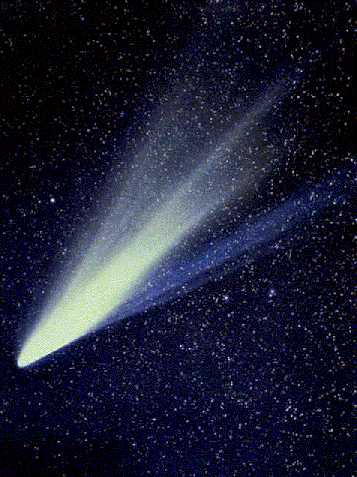
The comet West: below Ė
plasma tail (electrically charged particles), above Ė dust tail (John Laborde)
The Death of a Comet
At the end of several passages through the internal solar system, the
volatile materials of the comets are exhausted, being the latter converted into
inactive objects.
_